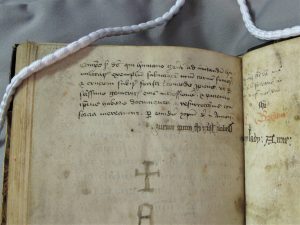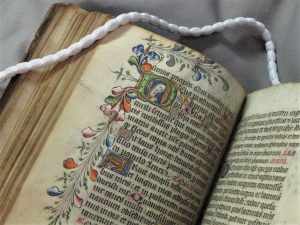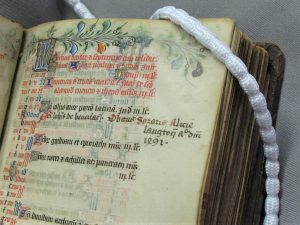For the 2022-2023 school year I was privileged enough for the opportunity to volunteer at the University of Exeter’s special collections. My duty was cataloguing Syon Abbey’s mediaeval manuscripts. Syon Abbey belonged to the Bridgettine Order. It was the only Bridgettine house for women in England. It was really fascinating to work with these manuscripts, piece together how they were made, and how they might have been used by the nuns.
I’ve been able to look at a lot of mediaeval manuscripts during my studies at Exeter. I’ve looked at manuscripts online and in person at the Exeter Cathedral, Oxford, Stockholm, and Munich. Manuscripts commonly have red rubrication to mark paragraphs. However, Syon Abbey is unique in its use of yellow ink for rubrication. This collection is also special in its use of charming little human profiles on some of the letters. It’s always a treat to find one!EUL MS 262/1 is one of the manuscripts I catalogued. It is a processional and contains an example of mirror writing on folio 128v. No other catalogues mentioned that was in the manuscript, so it was really cool to find something that others had missed.
EUL MS 262/2 is small, but the art is still incredibly detailed. It contains many historiated initials of the Virgin Mary and an unidentified woman (possibly Mary Magdalen?), calling attention to the fact this manuscript was made for and used by nuns. The Virgin Mary and the other woman both wear beautiful clothes with gold embroidery. The colours are still incredibly vibrant despite being made centuries ago.
The archives welcome classes of students to come see the manuscripts. During one class, Professor Catherine Rider pointed out Sister Alice’s obituary to me. On folio 3r, of EUL MS 262/2 the calendar documents Sister Alice Langton (one of the nuns) died in 1491. This is just one example of how the nuns used the manuscripts. Perhaps Sister Alice’s fellow nuns added her name in this manuscript because it was one of her favourites as a way to celebrate her life.I really enjoyed cataloguing seven of Syon Abbey’s manuscripts this school year. It was an amazing experience to handle books that have been used for centuries before me!


